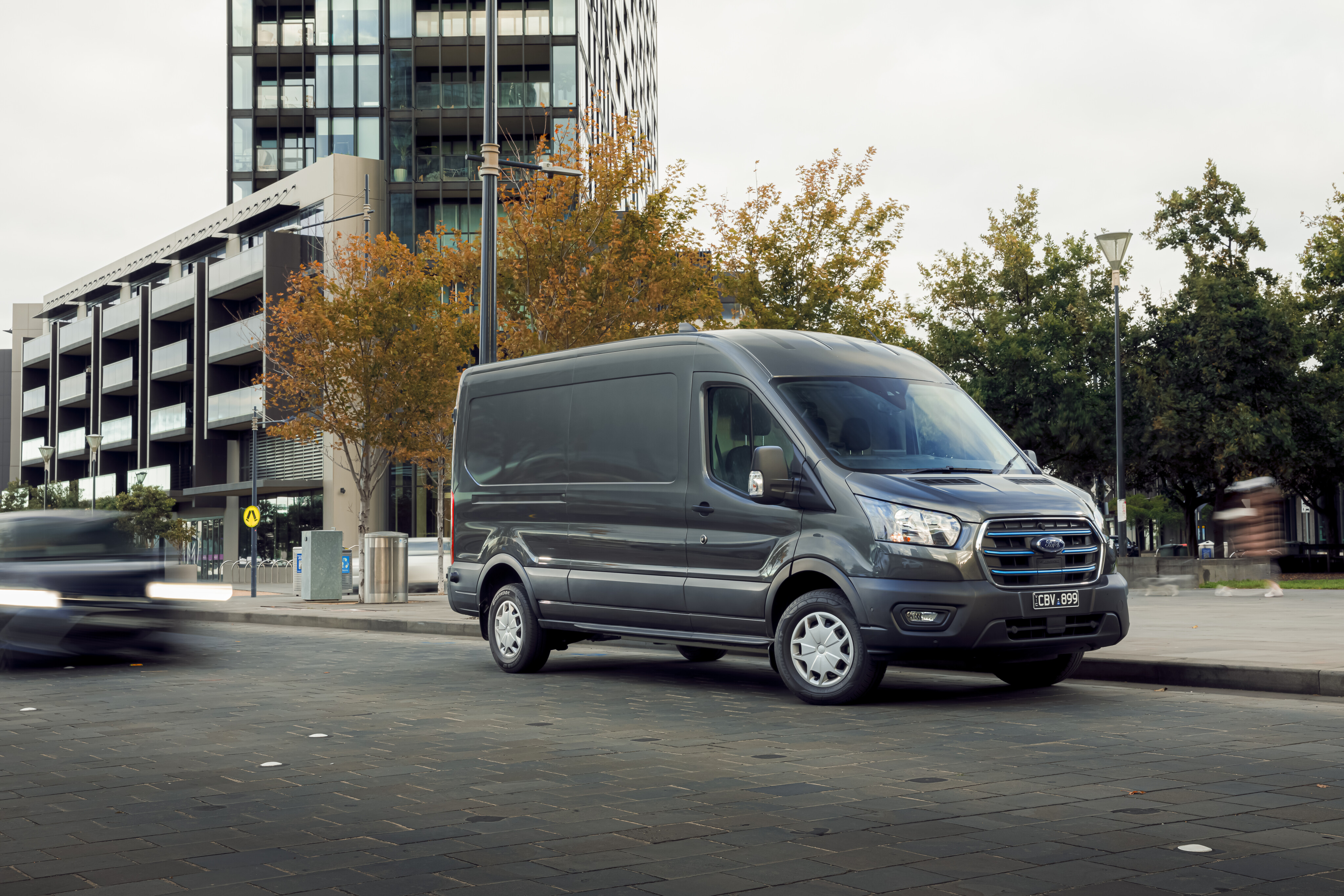
Score breakdown
Things we like
- Most refined Transit yet
- Thoughtful, practical ergonomics
- Clever tech for a work van
Not so much
- Huge price gap from diesel Transits
- Driving range may limit applications
- Reduced legroom for standard middle seat
It’s hard to deny, electric vans are a thing now – and they're becoming increasingly capable in range and capacity.
Now Ford is in the mix, with its new E-Transit promising lower running costs and an eco focus. Lower running costs come at the expense of a rather intimidating purchase cost, however – even despite a sharpened new drive-away price.
Ford’s pricing strategy will likely push the E-Transit out of relevance for the small independent business owner – but it's the big fleets that are most likely to be drawn to electrification in the (expensive) short term.
For those fleets with big contracts, increasing electric vehicle quotas and big-number purchase orders, Ford is pitching its new E-Transit as the same Transit you know and love – with the added refinement, ease of use, and running cost advantages of an EV powertrain.
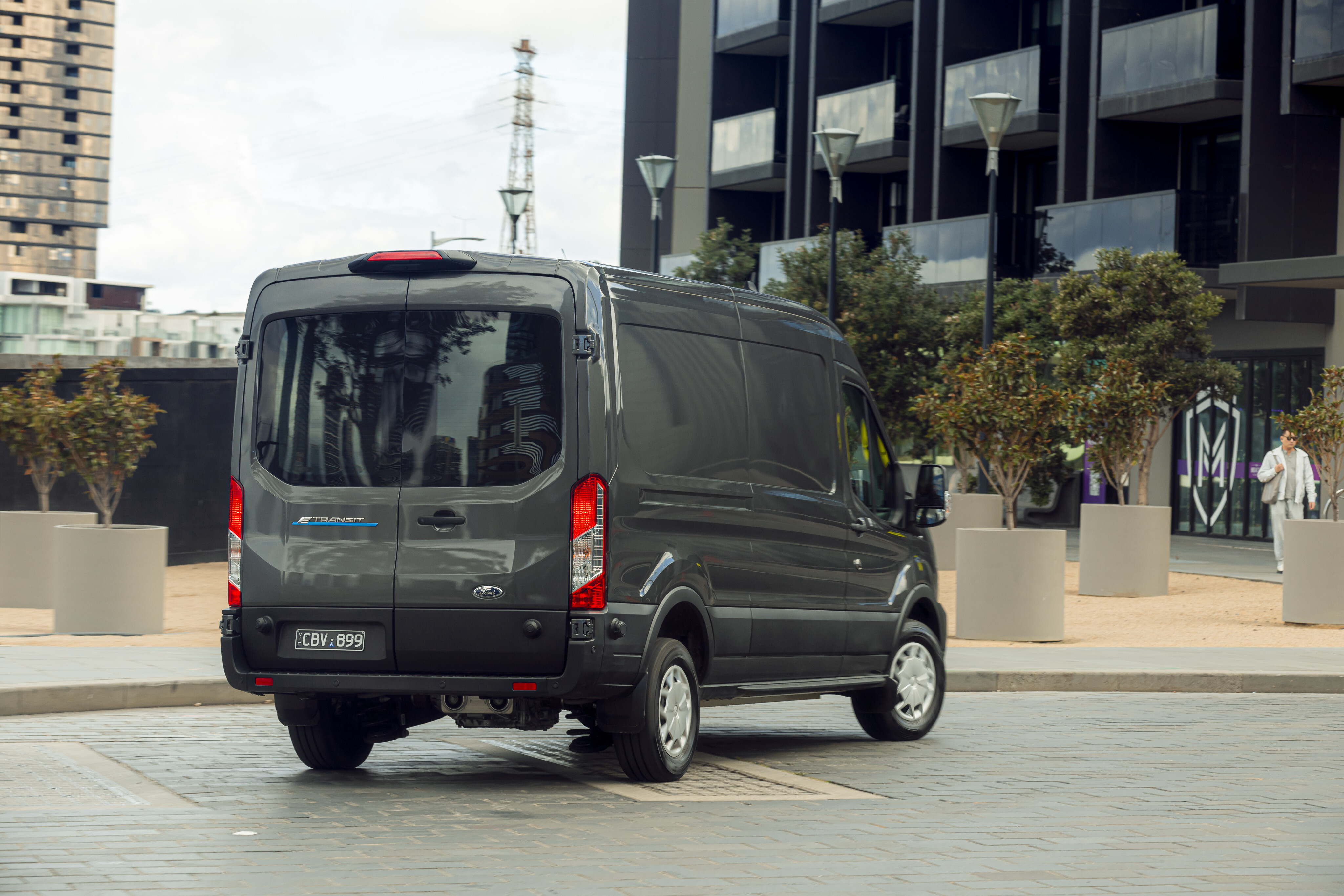
JUMP AHEAD
- How much is it, and what do you get?
- How do rivals compare on value?
- Interior comfort, space and storage
- Technology in the cabin
- What is it like to drive?
- How much energy does it use?
- How safe is it?
- Warranty and running costs
- VERDICT
- Specifications
How much is it, and what do you get?
Two long-wheelbase E-Transit body variants are on offer, comprising a standard ‘mid-roof’ van and a ‘high-roof’ option.
For the standard mid-roof, there's a new national drive-away price of $99,990 – marking an improvement on the $104,990 that was asked at its Australian launch in 2023.
Options include two special paint palettes, titled Prestige and Special Vehicle Options (SVO).
Buyers can also choose to swap the dual front passenger jump seats with a single seat (reducing cabin occupancy from three to two) as well as the option of dual sliding side doors.
| 2024 Ford E-Transit Pricing (before on-road costs) | |
|---|---|
| Mid-roof | $104,990 |
| High-roof | $106,490 |
| Options | Price |
|---|---|
| Prestige paint | $700 |
| SVO paint | $1400 |
| Single front passenger seat | $150 |
| Dual side load doors | $1000 |
| High roof | $1500 |
Power, range & charging
All E-Transits are driven by a rear subframe-mounted 198kW/430Nm motor, powered by a 68kWh lithium-ion battery contained within the load floor structure.
The motor spins the rear wheels exclusively through a single-speed automatic transmission.
The basics
| 2024 Ford E-Transit Specifications | |
|---|---|
| Body | 4-door, 3-seat van |
| Drive | rear-wheel |
| Motor & transmission | single rear, single-speed auto |
| Battery | 68kWh lithium-ion |
| Charging | 115kW (15-80% 34min) |
| Power & torque | 198kW & 430Nm |
| Range | 295-307km (WLTP) |
| Weight | 2639/2684kg |
| L/W/H | 5972/2473/2474mm |
Ford’s new E-Transits claim a WLTP driving range of 307km for the mid-roof body, which is only slightly hampered at 295km for the high-roof variant.
Those aren't headline numbers by today's standards but, according to Ford's research, it's more than double the distance travelled by the average working diesel van in a day.

A maximum DC fast charging rate of 115kW is claimed to restore the battery from 15 to 80 per cent in 34 minutes.
Overnight AC charging using a wallbox should complete a full 0-100 per cent cycle in around eight hours.
A variety of regenerative braking and driving modes are selectable via the interior rotary controller; comprising Normal, Slippery (for low-grip conditions) and Eco (to maximise driving range and minimise energy use) settings.
| 2024 Ford E-Transit standard features | |
|---|---|
| 16-inch steel wheels | 12-inch infotainment screen |
| Ford SYNC4 infotainment system | DAB+ Radio |
| Wireless Apple CarPlay & Android Auto | Drive Modes: Eco, Slippery, Normal |
| Satellite navigation | Over-the-air updates |
| Two USB ports | FordPass Connect |
| Four-speaker stereo | 4.2-inch semi-digital instrument cluster |
| Single-zone climate control | Artificial leather-wrapped steering wheel |
| Cloth upholstery | Rain-sensing wipers |
| Heated front seats | |
Like its combustion-powered counterparts in the rest of the Transit range, the E-Transit delivers a big step up in technology.
That includes a large 12-inch infotainment screen, Ford’s deft new Sync4 operating system, wireless Apple CarPlay and Android Auto, in-built satellite navigation with live features and scheduled cabin pre-conditioning (one of several pragmatic features available to owners via the FordPass app).
Differentiating an E-Transit from a standard Transit is a front grille adorned with blue highlights and a front-facing charging port, and E-Transit badging on the rear left barn door.
Its rear subframe, containing the electric motor, is somewhat visible when following one in traffic but, on the whole, Ford’s integration of its electric powertrain is very well done.
How do rivals compare on value?
The LDV eDeliver 9 electric van joins the brand’s burgeoning electric range and similarly offers a large commercial-oriented van with an electric powertrain.
The LDV’s asking price undercuts the E-Transit slightly, starting at $99,990 before on-road costs.
Putting the two in perspective, among their combustible-consuming counterparts, the LDV eDeliver commands a 49.2 per cent premium over the flagship diesel-powered LDV Deliver 9 LWB van.
Ford’s entry E-Transit, however, is 66.4 per cent costlier than the $63,090 Ford Transit 430E Jumbo with automatic transmission.

It's no cargo carrier, but the Mercedes-Benz EQV is another electrified van based on an existing combustion variant.
As a large luxury people mover rather than a load-lugging workhorse, the price disparity between the $132,480 diesel-powered V300 Avantgarde and $155,338 Mercedes-Benz EQV, is 17.3 per cent.
That's not too bad, considering that the popular Hyundai Kona Electric is about 30 per cent pricier than the equivalent combustion Kona variant.
Make what you will of Ford's position, but it's clear they're eyeing fleet managers.
There are, of course, other popular commercial vans from established brands including the smaller Renault Trafic (from $48,200 to $62,200 before on-road costs) and Volkswagen Crafter (from $49,890 to $91,490 before on-road costs). These, however, are yet to offer a fully electric powertrain to match that of Ford’s E-Transit.
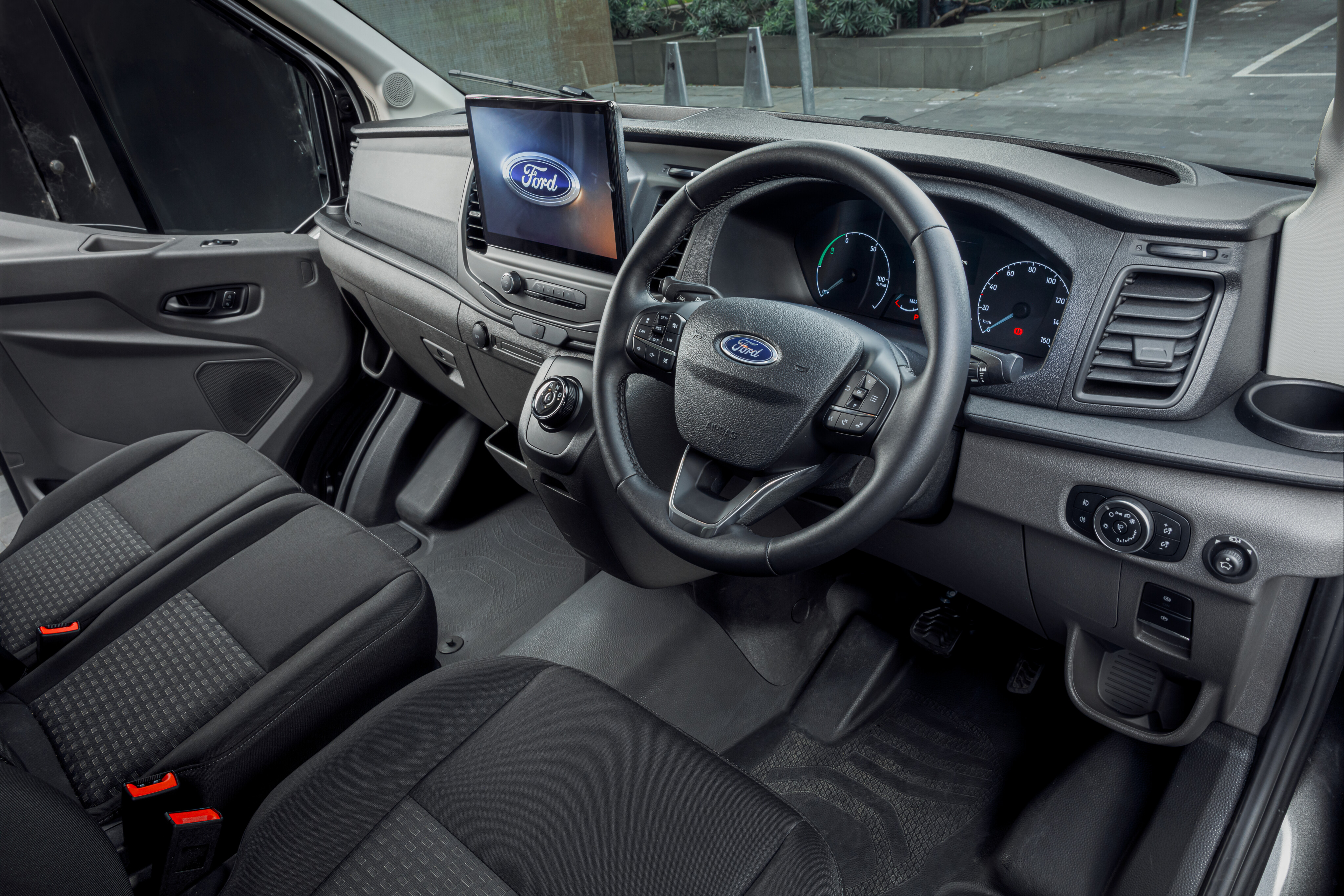
Interior comfort, space and storage
Ford seems mindful that Transit vans earn a living for their owners and drivers, having thoughtfully designed the cabin to be a durable, ergonomic and functional place.
The driver’s seat has a good degree of adjustability, with a tilting base and flip-down armrest, and a steering column with both height and telescopic adjustment.
Fitted standard with a three-person configuration, things can get a little snug for an adult in the middle, as the base of the rotary gear selector impinges on leg space.
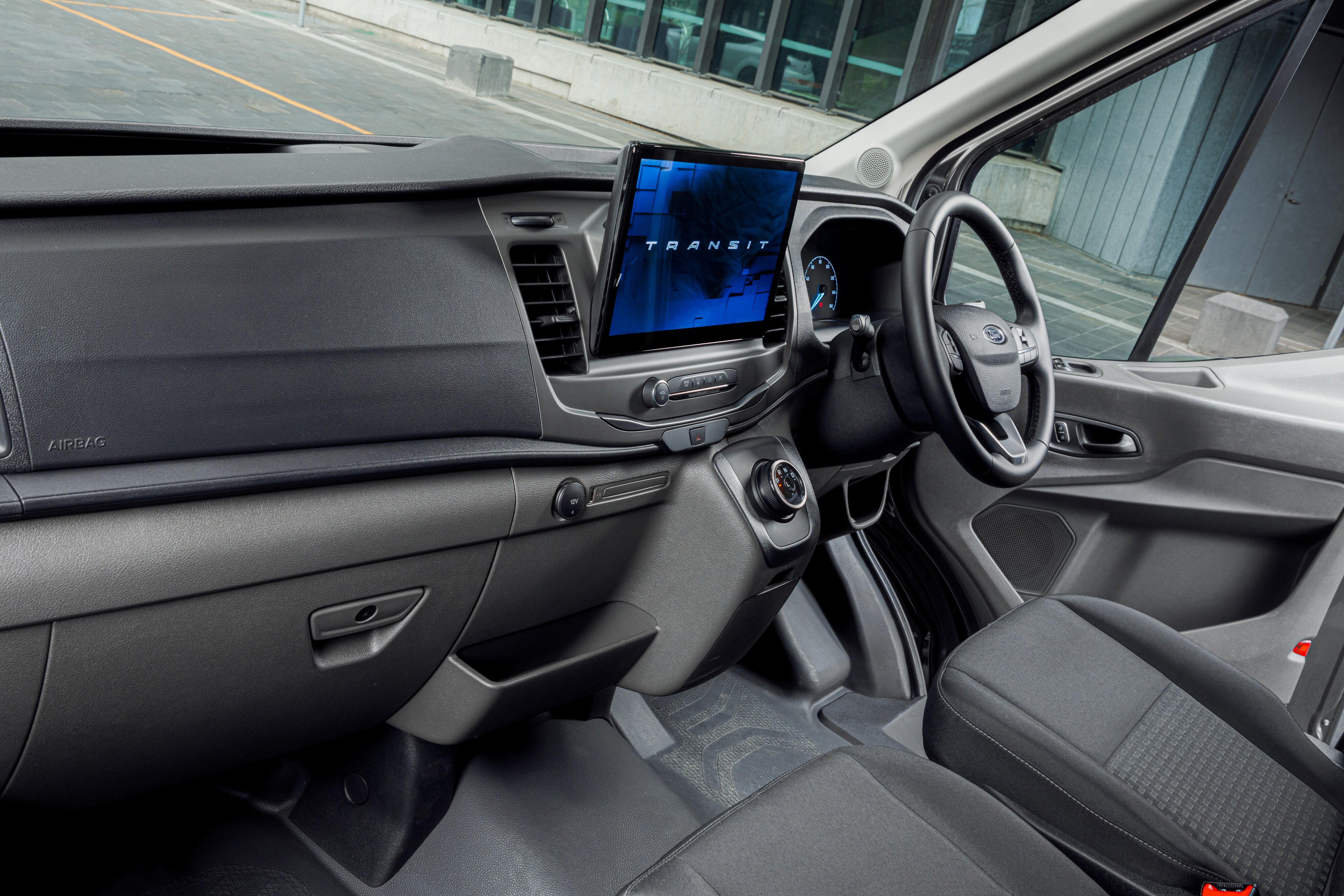
Elsewhere, the E-Transit nails its in-cabin storage, with a big hidden bin under the front seat, large camping bottle holders in the doors and in front of the occupants’ knees, plus more pop-out cup holders next to the air vents, an open bin to the left of the centre console, sections of open cubbies across the dash top, a large enclosed glovebox and even overhead storage.
A 12-volt socket and USB-C port are provided ahead of the driver in one of the dash top’s open cubbies, with another USB port and front-facing 12v socket for passengers on the dash fascia.
The instrument cluster is an intuitive blend of analogue dials and a digital central multi-function display featuring a digital speedometer and essential drive information.

2023 Ford E-Transit cargo space
The cavernous hold, separated from the passenger compartment with a fixed bulkhead, is accessible through the rear 270-degree barn doors or through the standard single sliding door (dual sliding side doors are optional).
| E-Transit cargo space | Mid-roof | High-roof |
|---|---|---|
| Load space max (cubic metres) | 11 | 12.4 |
| Gross vehicle mass (kg) | 4250 | 4250 |
| Max payload (kg) | 1611 | 1566 |
| Kerb weight (kg) | 2639 | 2684 |
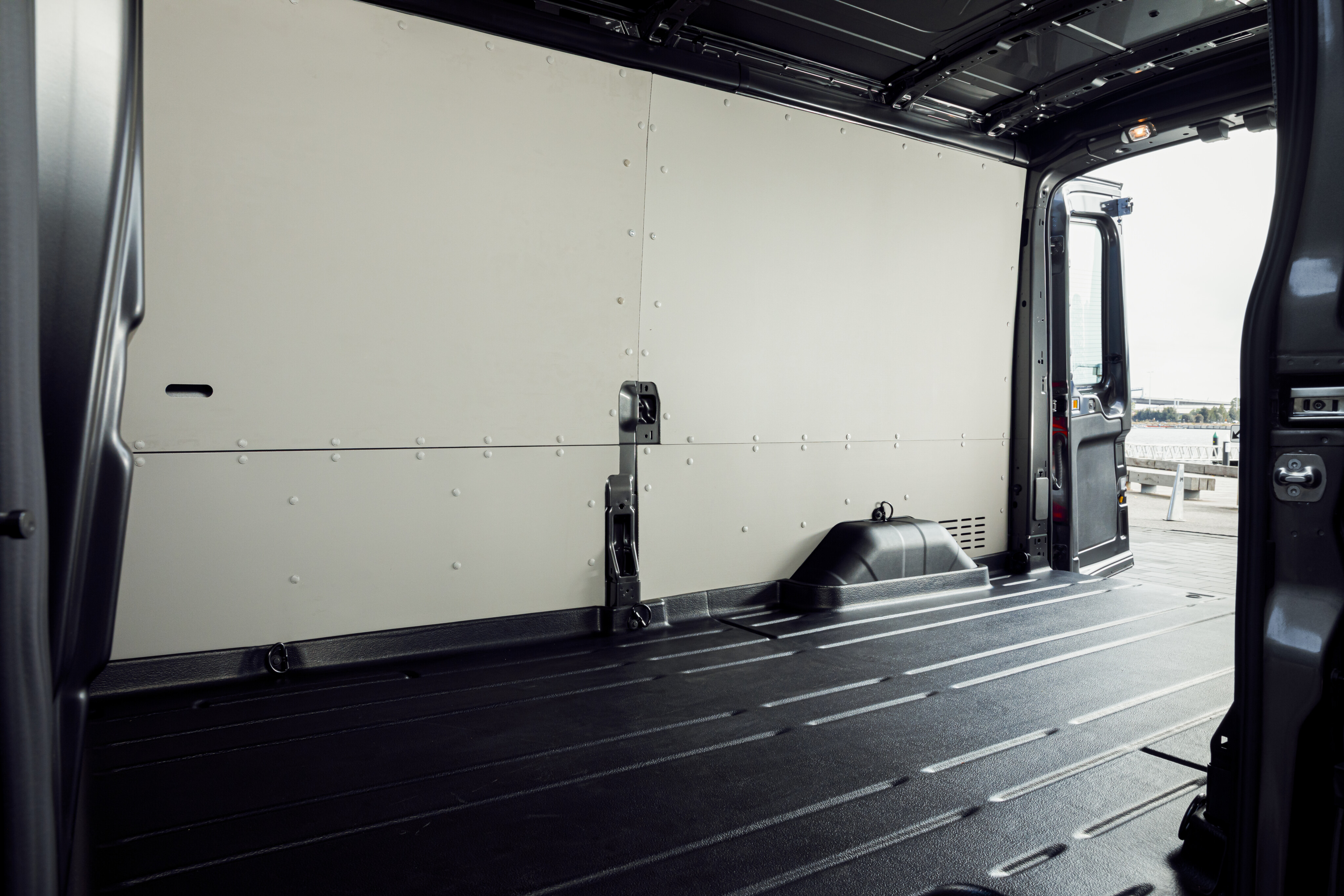
The E-Transit has a cargo capacity of 11 cubic metres in mid-roof configuration and 12.4 cubic metres in high-roof guise.
The load floor measures 3494mm in length and 1794mm wide, shrinking to 1392mm between the wheel tubs.
This sees the load space emerge remarkably similar in size to existing Transit variants of this generation, with any load area fit-outs able to feasibly be transferred into a new E-Transit with little modification or vehicle downtime.
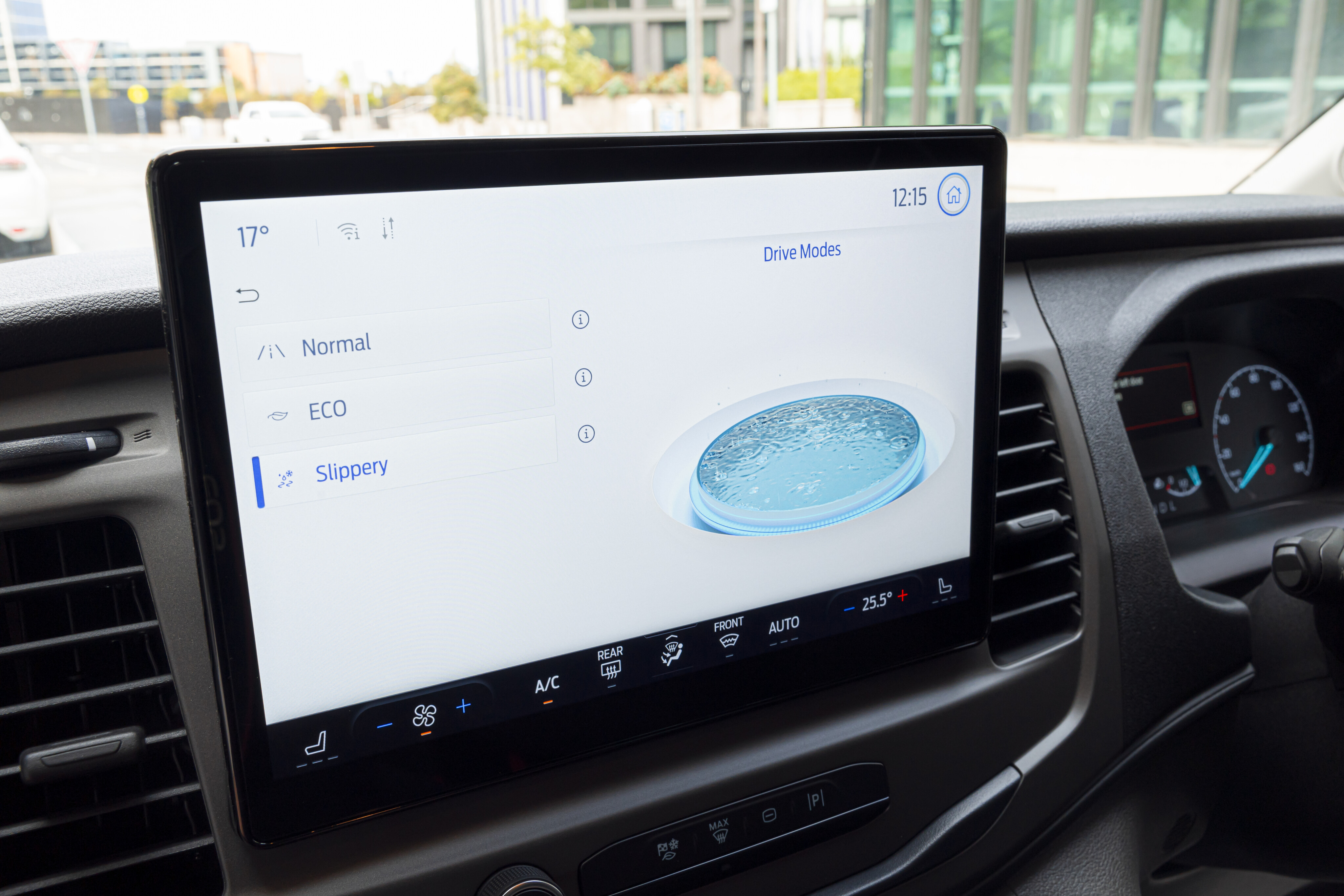
Technology in the cabin
Ford’s latest infotainment system is displayed through a new, larger 12-inch screen featuring DAB+ radio and satellite navigation with real-time updates, as well as wireless Apple CarPlay and Android Auto.
It works to great effect, with crisp, responsive visual and haptic feedback, and largely intuitive menu trees displayed through a crisp, glare-resistant, display.

What is it like to drive?
While many EVs boast headline power outputs and eye-widening 0-100km/h times, the electrified Transit’s pace can be fairly described as brisk, effortless, even, in the way it gets moving.
When unladen, it’s rather sprightly (for its size) and entertaining drive. The weight is low and centralised, which feels as though it helps the ride, helping tame the bucking and low bump resistance prevalent in lighter unladen commercial vans.
The throttle calibration is easy to key into, with a tractable and measured swathe of torque and the ability to confidently power down much earlier than in the comparatively laggy diesel vans.

Overall, it’s a much more refined, intuitive driving experience.
Even when deliberately trying to upset the van in small suburban corners, it displays a confident level of resistance to understeer or oversteer resistance.
Regenerative braking forces can be varied between drive modes but the E-Transit doesn’t boast the aggressive deceleration of some EVs.
The scientific consensus on aggressive regen is still up in the air, and the Transit strikes a nice balance between making the most of its available range and delivering an instinctual, effortless learning curve.
The rotary gear selector is a breeze to use and agreeably responsive with only a slight delay experienced when flicking between reverse and drive during a hurried suburban three-point turn.
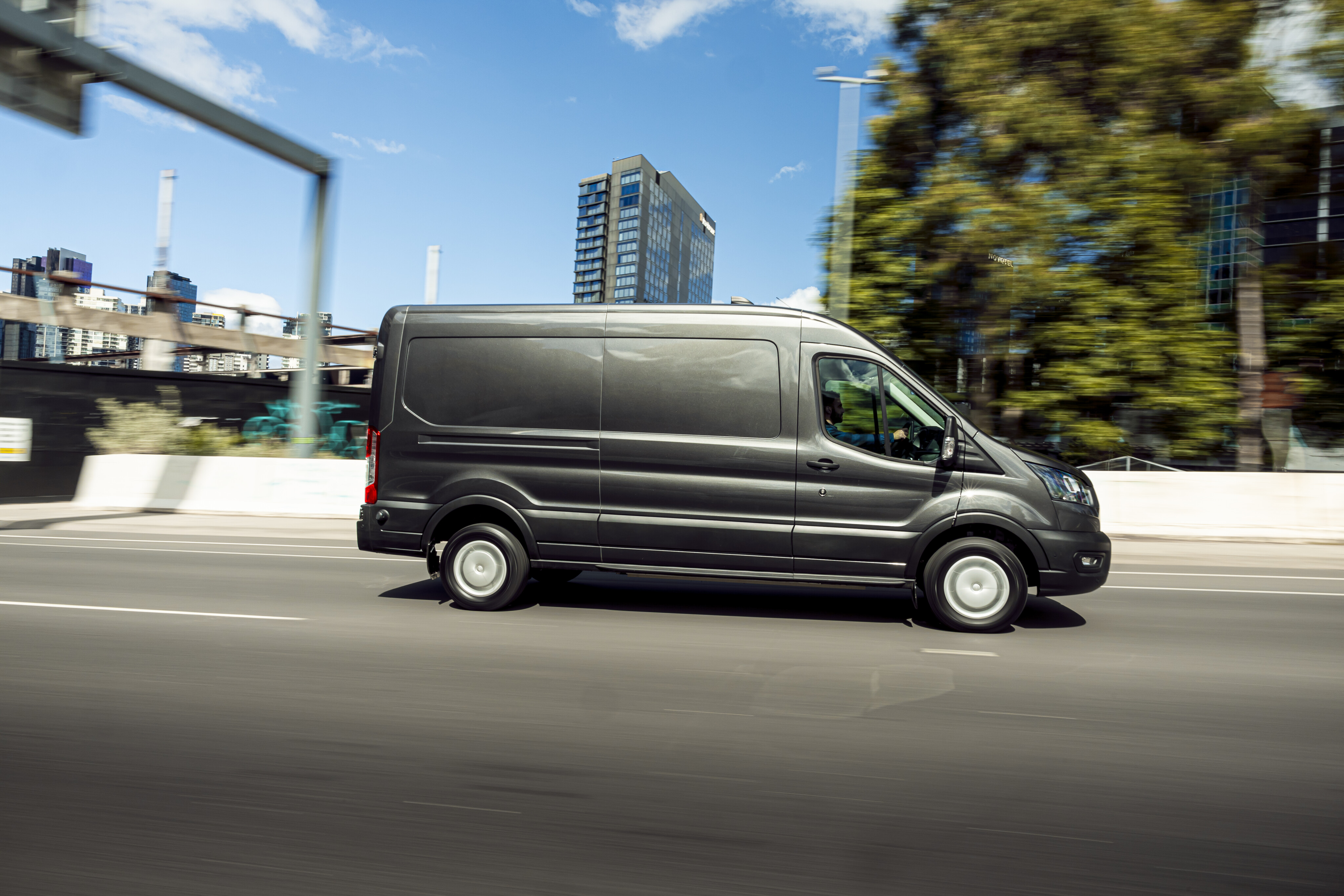
Elsewhere, Ford has paid attention to making the e-Transit an entrusted workhorse, with great forward visibility and a surprisingly small turning circle.
The high-mounted rear camera is a quality unit, illustrating the van’s surroundings on the 12-inch screen with clarity, and makes reverse parking this long-wheelbase van a surprisingly easy assignment.
Overall, it still feels like the Transit we know and love, but with a noticeable step up in pace, refinement and the subtle arrest of unbecoming dynamic traits typical to combustion vans, like excess body roll and body shake.

How much energy does it use?
The single-day launch route was rather short, which made reliable energy figures difficult to attain.
Most vans at the event were displaying around 24kWh/100km on the trip computer, but we will report back when we have an E-Transit through the office for more thorough testing.
How safe is it?
Ford’s Transit van range, including the E-Transit, remain unassessed by ANCAP.
Despite this, the E-Transit concedes none of the Transit’s existing safety suite, including six airbags: dual front, side and curtains, as well as active safety features, including:
| Ford E-Transit safety features | |
|---|---|
| Autonomous emergency braking (AEB) w/ pedestrian detection | Adaptive cruise control |
| Blind spot monitoring | Blind spot assist |
| Hill launch assist | Intersection assist |
| Lane keeping aid | Lane departure warning |
| Traffic sign recognition | Rear camera |
| Rear parking sensors | Auto hold |
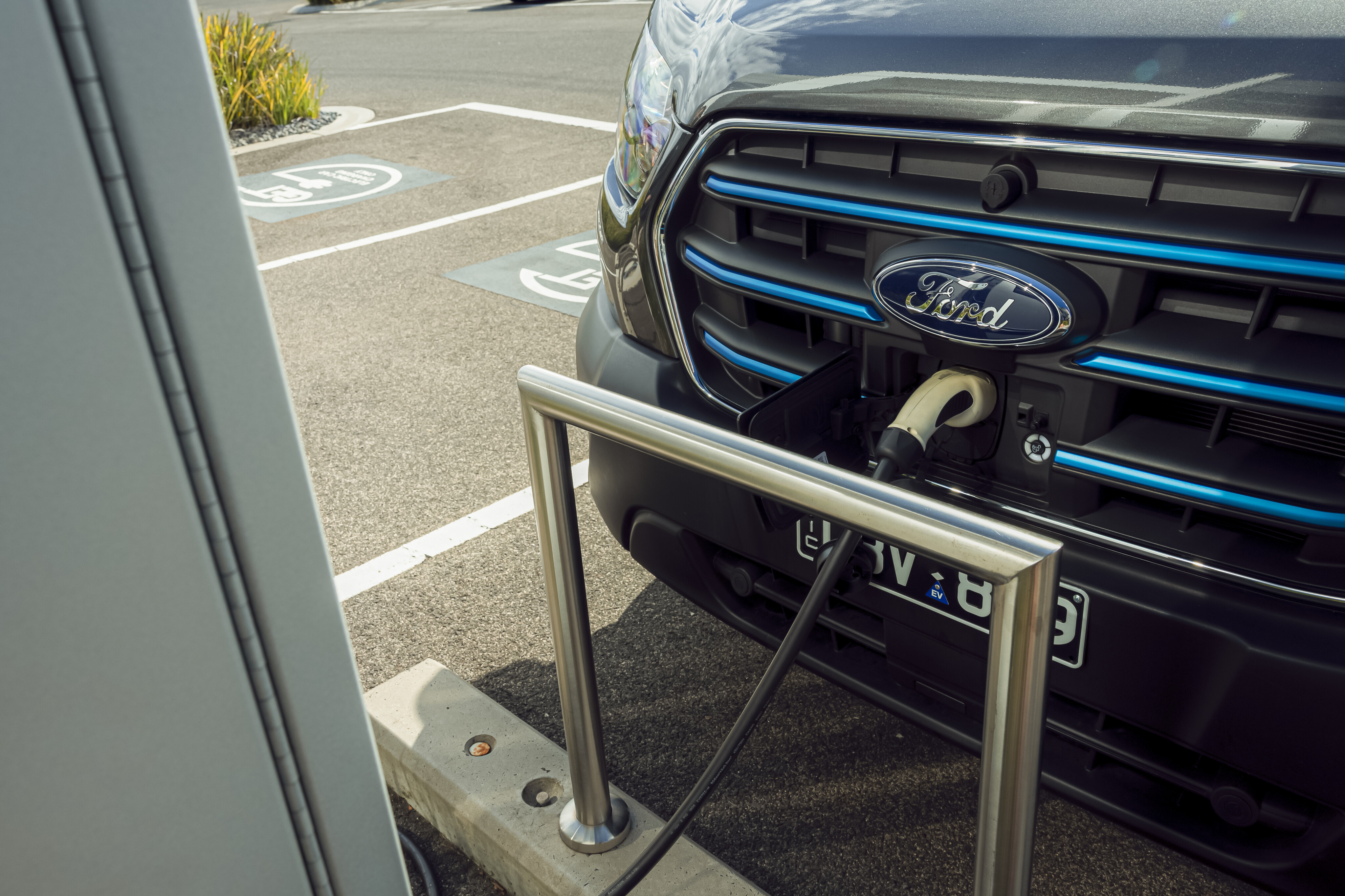
Warranty and running costs
The E-Transit carries a Ford vehicle warranty of five years with unlimited kilometres, along with a battery and high-voltage componentry warranty spanning eight years or 160,000km.
Service intervals run annually, or every 30,000km, whichever occurs first.

VERDICT
Ford’s E-Transit should prove compelling for fleets with the budget to take it on. It delivers a level of increased refinement and moves the game on from its established diesel-drinking counterparts in a meaningful, tangible way.
It’s the same well-known capable, ergonomic moving master and, in many ways, the quick, decisive development of the E-Transit’s EV powertrain – which Ford says is largely made up of existing Mustang Mach-E bits – just makes sense.
The same may not be said by private Australian buyers, however, when it comes to local E-Transit pricing. Sadly, the price disparity between conventional diesel-powered Transits and the six-figure E-Transit is hard to stomach.
Doubly so, when you consider that, in its domestic American market, the price difference between a conventional diesel Transit van and an E-Transit is a comparatively modest AU$15,000.
It’s a shame, as there are a lot of clever things going for the E-Transit. It’s a good product in isolation and, were it priced closer to its established diesel range, it would almost be a no-brainer. But, for working drivers without a fleet contract to lean on, along with the recent rollback of the instant asset write-off scheme, we’re left wondering whether the numbers really add up.
The humble Transit van has always been the quiet achiever of Ford's product portfolio. More than Ford's first dedicated electric powertrain delivered to the Australian market, it's an ambitious pricing strategy that will likely relegate the otherwise meritorious E-Transit to a silent operator.
Specifications
| 2024 Ford E-Transit Specifications | |
|---|---|
| Body | 4-door, 3-seat van |
| Drive | rear-wheel |
| Motor | single rear |
| Transmission | single-speed automatic |
| Power | 198kW |
| Torque | 430Nm |
| Energy consumption | 25kWh/km (estimated) |
| Range | 295-307km (WLTP) |
| Weight | 2639/2684kg |
| Suspensions | four-link front / independent rear trailing arm |
| L/W/H | 5972/2473/2474mm |
| Wheelbase | 3759mm |
| Tyres | 235/65 R 16 (f/r) Hankook Vantra LT |
| Wheels | 16 x 6.5J alloy (spare) |
More EV stories to help you choose the best car for your needs
🚘 EV news, reviews, advice & guides
- ❓ Short & sweet: Your EV questions answered
- ⚡ New EVs: Everything coming to Australia
- 🥇 Australia's EVs with the longest driving range
- ⚖️ Best-value EVs by driving range
- 💰 How much do EVs cost in Australia?
- 😰 How much more expensive are EVs?
- ⚖️ Number crunching: Is it time to switch to an EV?
- ♻ Should you buy a used EV?
- 🛡️ Are EVs more expensive to insure?
- 🆚 Costs compared: Charging an EV vs fueling a car
- 📖 EV charging guide
- 👨🔧 EV servicing explained
- 🔋 EV battery types explained
- 🪫 When do EV batteries need replacing?
- 🆚 Hydrogen v EVs: What's best for Oz?
MORE advice stories to help you with buying and owning a car
Wheels thanks Alex Affat for this story's original form.
Score breakdown
Things we like
- Most refined Transit yet
- Thoughtful, practical ergonomics
- Clever tech for a work van
Not so much
- Huge price gap from diesel Transits
- Driving range may limit applications
- Reduced legroom for standard middle seat

COMMENTS